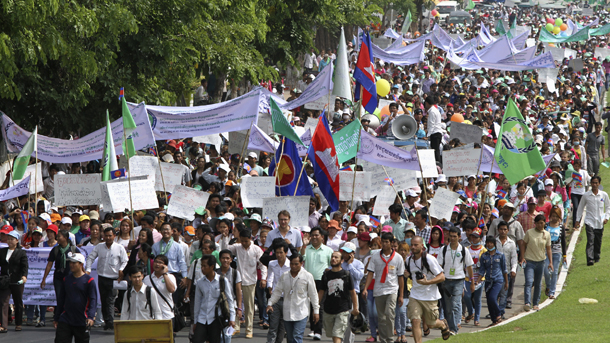May Day moved beyond its roots as an international workers’ holiday to become a day of mass protest on Tuesday, with rallies throughout Asia demanding wage increases and marches planned across Europe over government-imposed austerity measures.
Thousands of workers protested in the Philippines, Indonesia and Taiwan and other Asian nations, with the demand for wage hikes amid soaring oil prices a common theme. They said their take-home pay could not keep up with rising consumer prices, while also calling for lower school fees and expressing a variety of other gripes.
In the Philippine capital, Manila, more than 8,000 members of a huge labor alliance, many clad in red shirts and waving red streamers, marched under a brutal sun for 2.5 miles to the heavily barricaded Mendiola bridge near the Malacanang presidential palace, which teemed with thousands of riot police, Manila police chief Alex Gutierrez said.
Another group of left-wing workers later burned a huge effigy of President Benigno Aquino III, depicting him as a lackey of the United States and big business. A few hundred workers marched to the US Embassy, but were stopped by riot police about a block away. The protesters burned a mock US flag and went away.
Aquino rejected their calls for a US $3 daily pay hike, which he warned could worsen inflation, spark layoffs and turn away foreign investors.
Aside from pay hikes, protest leader Josua Mata from the Alliance of Progressive Labor urged Aquino to back proposed legislation against the widespread practices by businesses of contracting out certain operations to other companies to save on costs and prevent workers from organizing trade unions.
In Indonesia, thousands of protesters demanding higher wages paraded through traffic-clogged streets in the capital, Jakarta, where 16,000 police and soldiers were deployed at locations including the presidential palace and airports.
In Taiwan, several thousand anti-government protesters marched through downtown Taipei, demanding higher wages, lower school tuition and better conditions for foreign workers. Workers waving the Thai flag rallied in Bangkok for better pay.
“It is always the case that low-income groups across Asia feel a disproportionately larger impact of rising prices,” said Wai Ho Leong, a Singapore-based economist with Barclays Capital. “Coupled with rising inflation expectations, the case is building to do more for lower income [workers]. Minimum wages are one way.”
In Kuala Lumpur, Malaysia, some 500 people rallied, calling for a higher minimum wage than the one announced Monday by Prime Minister Najib Razak.
Najib’s plan for the country’s first-ever minimum wage calls for minimum monthly pay of 900 ringgit ($297) for private-sector workers in peninsular Malaysia and 800 ringgit ($264) in two poor eastern states. The move is expected to benefit 3.2 million low-income workers, who account for about a third of the country’s workforce.
The protesters marched from a market to the headquarters of Maybank, the nation’s largest bank, calling for a minimum monthly wage of 1,500 ringgit ($496) a month.
In Hong Kong, more than 1,000 joined a protest march to demand that the city’s minimum wage, which was introduced exactly a year ago, be raised to 33 Hong Kong dollars ($4.25) per hour from HK$28 ($3.60), according to local broadcaster RTHK. They also want the government of the southern Chinese financial hub to implement a 44-hour work week.
In nearby Macau, about 500 people marched for workers’ rights and full democracy in the legislature, the broadcaster said.
In debt-crippled Greece, more than 2,000 people marched through central Athens in subdued May Day protests centered on the country’s harsh austerity program. Other Europeans will also take to the streets to protest measures to cut spending that are being blamed for a big jump in the number of unemployed, particularly in Spain, where one in four people is now out of work.
In the United States, demonstrations, strikes and acts of civil disobedience are planned, including what could be the country’s most high-profile Occupy rallies since the anti-Wall Street encampments came down in the fall.
Around 100,000 people in Moscow—including President Dmitry Medvedev and president-elect Vladimir Putin—took part in the main May Day march through the city center.
Television images showed the two leaders happily chatting with participants on the clear-and-cool spring day.
Many banners and placards criticized the Russian opposition movement that has become more prominent in Moscow over the past half-year. One read “spring has come, the swamp has dried up,” referring to Bolotnaya (Swampy) Square, the site of some of the largest opposition demonstrations in recent months.

















